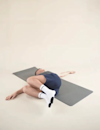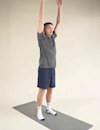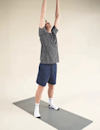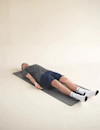Your Cart
Oops! Your cart is empty
2
Taking a more active approach to waking up can benefit the body and mind for the day (and years) to come. Here’s how to incorporate a quick stretch routine every morning.
There’s a lot of pressure these days to spring out of bed and feel like an active, productive member of society from the get-go. But, most of the time, instead of springing up and launching into a sweat-inducing HIIT routine, all we really want to do is grab our phones and spend ten more minutes under the covers, right?
There is a middle ground though. Whether you’re a yoga devotee, a pilates fan, or simply think you could benefit from a bit of a stretch first thing, getting your muscles loose can have a fantastic effect on your day, improving everything from sporting performance to posture and serotonin levels.
Not a fan of twisting yourself into a pretzel before your first coffee? No worries. Our experts break down the science of stretching and the one routine that actually matters.
"Stretching is essential for preventing injury, maintaining mobility, and reducing stiffness and tightness in the body that can lead to pain,” explains Michelle Polizzi, a certified 500-RYT yoga teacher (meaning she has instructed more than 500 hours of yoga). “This is especially true if you work at an office job, or another role that requires an unchanging state – all that sitting and holding without stretching first can make us more stiff, leading to reduced mobility.”
Polizzi also points out that stretching is also a great way to slow down and focus on our bodies – in other words, a much more mindful way to begin the day than scrolling TikTok.
For animals and infants, stretching is part of waking up. Only adult humans have gotten out of the habit. And we need to sort that out.
“Our bodies are extremely stiff in the morning because we've been in a static position all night,” explains Polizzi. “Morning stretching promotes blood flow to your muscles and helps activate the parasympathetic nervous system, which tells your body it's okay to release tension accumulated overnight.”
“The most common reason people pull a muscle in the morning is because the muscles shorten overnight while we sleep,” Polizzi adds. “The same thing can happen if you haven't worked out in a while, and you've been leading a more sedentary lifestyle.”
In other words, your morning stretch is essential for getting you up and going.
Not sure what counts as a stretch, or how long you should hold it? “There are three basic types of stretching: static, dynamic, and proprioceptive neuromuscular facilitation (PNF) stretching,” adds Anthony Maritato, a physical therapist and personal trainer at choosept1st.com.
Static stretching is the classic stretch-and-hold technique used by many athletes and fitness enthusiasts. This type of stretch may be held for 30 seconds to one minute, to increase the range of motion around a joint and increase the length of muscles and tendons.
Dynamic stretching involves stretching a muscle through motion. These motions may be performed quickly or slowly. Yoga is a great example of slow dynamic stretching while leg swings or arm circles could be an example of rapid movement, dynamic stretching.
Proprioceptive neuromuscular facilitation (PNF) stretching uses a combination of passive stretching and active muscle contractions to produce a neurological effect in the muscle to increase the range of motion. This is a more advanced strategy used by physical therapists and specialized practitioners. i.e. you’re unlikely to be doing the latter before your bowl of cereal.
There are a lot of benefits to incorporating a daily stretching routine.
Dynamic stretching is recommended before sports as a way to prepare the muscles and central nervous system for performance. After sports, static stretching may be used to increase the range of motion and improve recovery. “A large body of clinical evidence suggests static stretching before strength and power sports may diminish an athlete's athletic performance,” explains Maritato.
Stretching also affects posture, but not in the way you might think. “Posture is largely regulated by the central nervous system. Because of this, utilizing PNF strategies to retrain that central nervous system and create new postural positions may be one of the best strategies,” Maritato explains. Static stretches can also be used to help ease muscle soreness, too.
Interestingly, stretching can also affect our mental state. By getting the blood flowing to muscles, studies show stretching helps release feel-good, mood-boosting chemical endorphins – the same thing responsible for the ‘runner’s high’ post 5k.
“Human bodies are highly adaptive,” enthuses Maritato. “If a person stretches the same muscle or group of muscles daily, our body will respond by sending fibroblasts to the area to lay down new connective tissue. This connective tissue will actually lengthen the tendons or ligaments.”
In other words, the more you practice, the better you become. To help you get started, Maritato has put together a sequence of his five favorite moves, designed to benefit multiple muscle groups.
Try this a few mornings a week. The best thing is you don’t need to carve out 30 minutes to get it done – fit it into your schedule and you’ll feel the benefits in no time.
Lying with your back against the floor (preferably on an exercise mat), bring your knees up to your chest and outstretch your arms to help with balance during the movement.
Rotate the knees slowly to one side with control, working within your range of motion. Hold the position before rotating to the other side. Repeat the whole thing three times.
Stand tall with your arms outstretched. Fold your body forward, bringing your fingertips toward the floor. Relax your neck, allowing your head to comfortably hang down in front of your body.
Hold this position for 30 seconds before returning to the start. Repeat three times.
Standing with your feet shoulder-width apart, raise your hands in a triumphant victory pose, breathing deeply into the lower lobes of your lunges while you reach your fingertips toward the ceiling.
This is a dynamic stretch and does not require a sustained hold in the end position. Repeat ten times.
Lying face up on the floor, turn your palms toward the ceiling and allow your body to feel heavy on the ground.
Hold this position for 2 minutes while you concentrate on breathing deeply, filling the lower lungs with air. Perform once, as your final stretch.
Get 15% off your first order of $50, plus insider access to expert tips, exclusive discounts, and the latest from Huel.
This site is protected by reCAPTCHA and the Google Privacy Policy and Terms of Service apply. You can unsubscribe at any time. Huel Privacy Policy.






